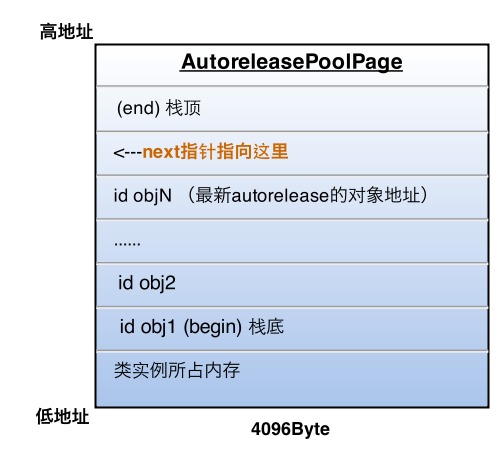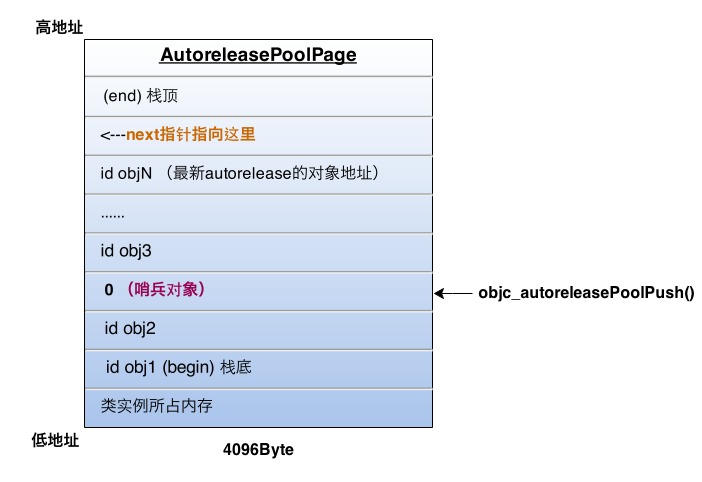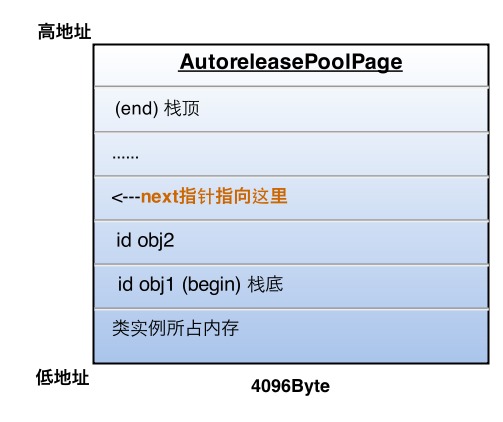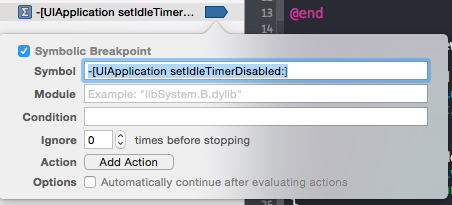最近在使用MSWeakTimer的时候,出现了crash的情况,在分析过程中发现了自己之前一直忽略的一些内容,简单做一下记录。
ps:后来在网上查到了两篇文章,很好的解释了这个问题。
http://blog.sunnyxx.com/2015/01/17/self-in-arc/
http://blog.sunnyxx.com/2014/10/15/behind-autorelease/
crash过程跟踪
ARC的工程,大致的调用代码如下:
// ...
// @property (nonatomic, strong) MSWeakTimer *countdownTimer;
// ...
_countdownTimer = [MSWeakTimer scheduledTimerWithTimeInterval:1.0
target:self
selector:@selector(timerCountDown:)
userInfo:nil
repeats:YES dispatchQueue:dispatch_get_main_queue()];
[_countdownTimer fire];
...
- (void)timerCountDown:(MSWeakTimer *)timer{
// ...
if(shouldDisableTimer){
[timer invalidate];
timer = nil;
}else{
// ...
}
}
最终崩溃的函数:
- (void)timerFired
{
// Checking attomatically if the timer has already been invalidated.
if (OSAtomicAnd32OrigBarrier(1, &_timerFlags.timerIsInvalidated))
{
return;
}
// We're not worried about this warning because the selector we're calling doesn't return a +1 object.
#pragma clang diagnostic push
#pragma clang diagnostic ignored "-Warc-performSelector-leaks"
[self.target performSelector:self.selector withObject:self];
#pragma clang diagnostic pop
if (!self.repeats)
{
[self invalidate];
}
}
崩溃在了if (!strongSelf.repeats)这一句,显示self已经是zombie对象。
断点跟踪发现,在selector中,self被置为nil。那就比较奇怪,拿到self不会在作用域范围内retaincount加1吗?
crash原因分析
根据oc的调用机制,第一个参数就是self,但是self作为参数,并不会增加引用计数。这样就解释了上面self为什么成为zombie。
具体的解释可以参照Clang 3.7 documentation,解释如下图:

如何解决crash
通过增加一个对self的强引用,保证在函数作用域内,self不会被释放。
- (void)timerFired
{
// Checking attomatically if the timer has already been invalidated.
if (OSAtomicAnd32OrigBarrier(1, &_timerFlags.timerIsInvalidated))
{
return;
}
MSWeakTimer *strongSelf = self;
// We're not worried about this warning because the selector we're calling doesn't return a +1 object.
#pragma clang diagnostic push
#pragma clang diagnostic ignored "-Warc-performSelector-leaks"
[self.target performSelector:self.selector withObject:self];
#pragma clang diagnostic pop
if (!strongSelf.repeats)
{
[strongSelf invalidate];
}
}
深入理解ARC下的Autorelease
到这里就结束了吗?有意思的在后面!
在不修改MSWeakTimer的情况下,如果将上面的代码:
[_countdownTimer fire];
改为:
[self.countdownTimer fire];
运行后就不会崩溃!!!

关于Autorelease,下面的内容摘自http://blog.sunnyxx.com/2014/10/15/behind-autorelease/。
AutoreleasePoolPage
ARC下,我们使用@autoreleasepool{}来使用一个AutoreleasePool,随后编译器将其改写成下面的样子:
void *context = objc_autoreleasePoolPush();
// {}中的代码
objc_autoreleasePoolPop(context);
而这两个函数都是对AutoreleasePoolPage的简单封装,所以自动释放机制的核心就在于这个类。
AutoreleasePoolPage是一个C++实现的类:

- AutoreleasePool并没有单独的结构,而是由若干个AutoreleasePoolPage以
双向链表的形式组合而成(分别对应结构中的parent指针和child指针)
- AutoreleasePool是按线程一一对应的(结构中的thread指针指向当前线程)
- AutoreleasePoolPage每个对象会开辟4096字节内存(也就是虚拟内存一页的大小),除了上面的实例变量所占空间,剩下的空间全部用来储存autorelease对象的地址
- 上面的
id *next指针作为游标指向栈顶最新add进来的autorelease对象的下一个位置
- 一个AutoreleasePoolPage的空间被占满时,会新建一个AutoreleasePoolPage对象,连接链表,后来的autorelease对象在新的page加入
所以,若当前线程中只有一个AutoreleasePoolPage对象,并记录了很多autorelease对象地址时内存如下图:

图中的情况,这一页再加入一个autorelease对象就要满了(也就是next指针马上指向栈顶),这时就要执行上面说的操作,建立下一页page对象,与这一页链表连接完成后,新page的next指针被初始化在栈底(begin的位置),然后继续向栈顶添加新对象。
所以,向一个对象发送- autorelease消息,就是将这个对象加入到当前AutoreleasePoolPage的栈顶next指针指向的位置。
释放时刻
每当进行一次objc_autoreleasePoolPush调用时,runtime向当前的AutoreleasePoolPage中add进一个哨兵对象,值为0(也就是个nil),那么这一个page就变成了下面的样子:

objc_autoreleasePoolPush的返回值正是这个哨兵对象的地址,被objc_autoreleasePoolPop(哨兵对象)作为入参,于是:
- 根据传入的哨兵对象地址找到哨兵对象所处的page;
- 在当前page中,将晚于哨兵对象插入的所有autorelease对象都发送一次- release消息,并向回移动next指针到正确位置;
- 补充2:从最新加入的对象一直向前清理,可以向前跨越若干个page,直到哨兵所在的page
刚才的
objc_autoreleasePoolPop执行后,最终变成了下面的样子:

嵌套的AutoreleasePool
知道了上面的原理,嵌套的AutoreleasePool就非常简单了,pop的时候总会释放到上次push的位置为止,多层的pool就是多个哨兵对象而已,就像剥洋葱一样,每次一层,互不影响。
Autorelease返回值的快速释放机制
值得一提的是,ARC下,runtime有一套对autorelease返回值的优化策略。
比如一个工厂方法:
+ (instancetype)createSark {
return [self new];
}
// caller
Sark *sark = [Sark createSark];
秉着谁创建谁释放的原则,返回值需要是一个autorelease对象才能配合调用方正确管理内存,于是乎编译器改写成了形如下面的代码:
+ (instancetype)createSark {
id tmp = [self new];
return objc_autoreleaseReturnValue(tmp); // 代替我们调用autorelease
}
// caller
id tmp = objc_retainAutoreleasedReturnValue([Sark createSark]) // 代替我们调用retain
Sark *sark = tmp;
objc_storeStrong(&sark, nil); // 相当于代替我们调用了release
一切看上去都很好,不过既然编译器知道了这么多信息,干嘛还要劳烦autorelease这个开销不小的机制呢?于是乎,runtime使用了一些黑魔法将这个问题解决了。
黑魔法之Thread Local Storage
Thread Local Storage(TLS)线程局部存储,目的很简单,将一块内存作为某个线程专有的存储,以key-value的形式进行读写,比如在非arm架构下,使用pthread提供的方法实现:
void* pthread_getspecific(pthread_key_t);
int pthread_setspecific(pthread_key_t , const void *);
说它是黑魔法可能被懂pthread的笑话- –
在返回值身上调用objc_autoreleaseReturnValue方法时,runtime将这个返回值object储存在TLS中,然后直接返回这个object(不调用autorelease);同时,在外部接收这个返回值的objc_retainAutoreleasedReturnValue里,发现TLS中正好存了这个对象,那么直接返回这个object(不调用retain)。
于是乎,调用方和被调方利用TLS做中转,很有默契的免去了对返回值的内存管理。
于是问题又来了,假如被调方和主调方只有一边是ARC环境编译的该咋办?(比如我们在ARC环境下用了非ARC编译的第三方库,或者反之)只能动用更高级的黑魔法。
黑魔法之__builtin_return_address
这个内建函数原型是char *__builtin_return_address(int level),作用是得到函数的返回地址,参数表示层数,如__builtin_return_address(0)表示当前函数体返回地址,传1是调用这个函数的外层函数的返回值地址,以此类推。
- (int)foo {
NSLog(@"%p", __builtin_return_address(0)); // 根据这个地址能找到下面ret的地址
return 1;
}
// caller
int ret = [sark foo];
看上去也没啥厉害的,不过要知道,函数的返回值地址,也就对应着调用者结束这次调用的地址(或者相差某个固定的偏移量,根据编译器决定)
也就是说,被调用的函数也有翻身做地主的机会了,可以反过来对主调方干点坏事。
回到上面的问题,如果一个函数返回前知道调用方是ARC还是非ARC,就有机会对于不同情况做不同的处理。
黑魔法之反查汇编指令
通过上面的__builtin_return_address加某些偏移量,被调方可以定位到主调方在返回值后面的汇编指令:
// caller
int ret = [sark foo];
// 内存中接下来的汇编指令(x86,我不懂汇编,瞎写的)
movq ??? ???
callq ???
而这些汇编指令在内存中的值是固定的,比如movq对应着0x48。
于是乎,就有了下面的这个函数,入参是调用方__builtin_return_address传入值。
static bool callerAcceptsFastAutorelease(const void * const ra0) {
const uint8_t *ra1 = (const uint8_t *)ra0;
const uint16_t *ra2;
const uint32_t *ra4 = (const uint32_t *)ra1;
const void **sym;
// 48 89 c7 movq %rax,%rdi
// e8 callq symbol
if (*ra4 != 0xe8c78948) {
return false;
}
ra1 += (long)*(const int32_t *)(ra1 + 4) + 8l;
ra2 = (const uint16_t *)ra1;
// ff 25 jmpq *symbol@DYLDMAGIC(%rip)
if (*ra2 != 0x25ff) {
return false;
}
ra1 += 6l + (long)*(const int32_t *)(ra1 + 2);
sym = (const void **)ra1;
if (*sym != objc_retainAutoreleasedReturnValue)
{
return false;
}
return true;
}
它检验了主调方在返回值之后是否紧接着调用了`objc_retainAutoreleasedReturnValue`,如果是,就知道了外部是ARC环境,反之就走没被优化的老逻辑。
其他Autorelease相关知识点
使用容器的block版本的枚举器时,内部会自动添加一个AutoreleasePool:
[array enumerateObjectsUsingBlock:^(id obj, NSUInteger idx, BOOL *stop) {
// 这里被一个局部@autoreleasepool包围着
}];
当然,在普通for循环和for in循环中没有,所以,还是新版的block版本枚举器更加方便。for循环中遍历产生大量autorelease变量时,就需要手加局部AutoreleasePool。
以上一段转载自sunnyxx的文章!
解答最后的问题
根据上面的分析,可以知道,当执行:
[self.countdownTimer fire];
Autorelease为我们做了:
id tmp = objc_retainAutoreleasedReturnValue([Sark createSark]) // 代替我们调用retain
MSWeakTimer *timer = tmp;
[timer fire];
objc_storeStrong(&timer, nil); // 相当于代替我们调用了release
参考资料:
http://clang.llvm.org/docs/AutomaticReferenceCounting.html
http://blog.sunnyxx.com/2014/10/15/behind-autorelease/







